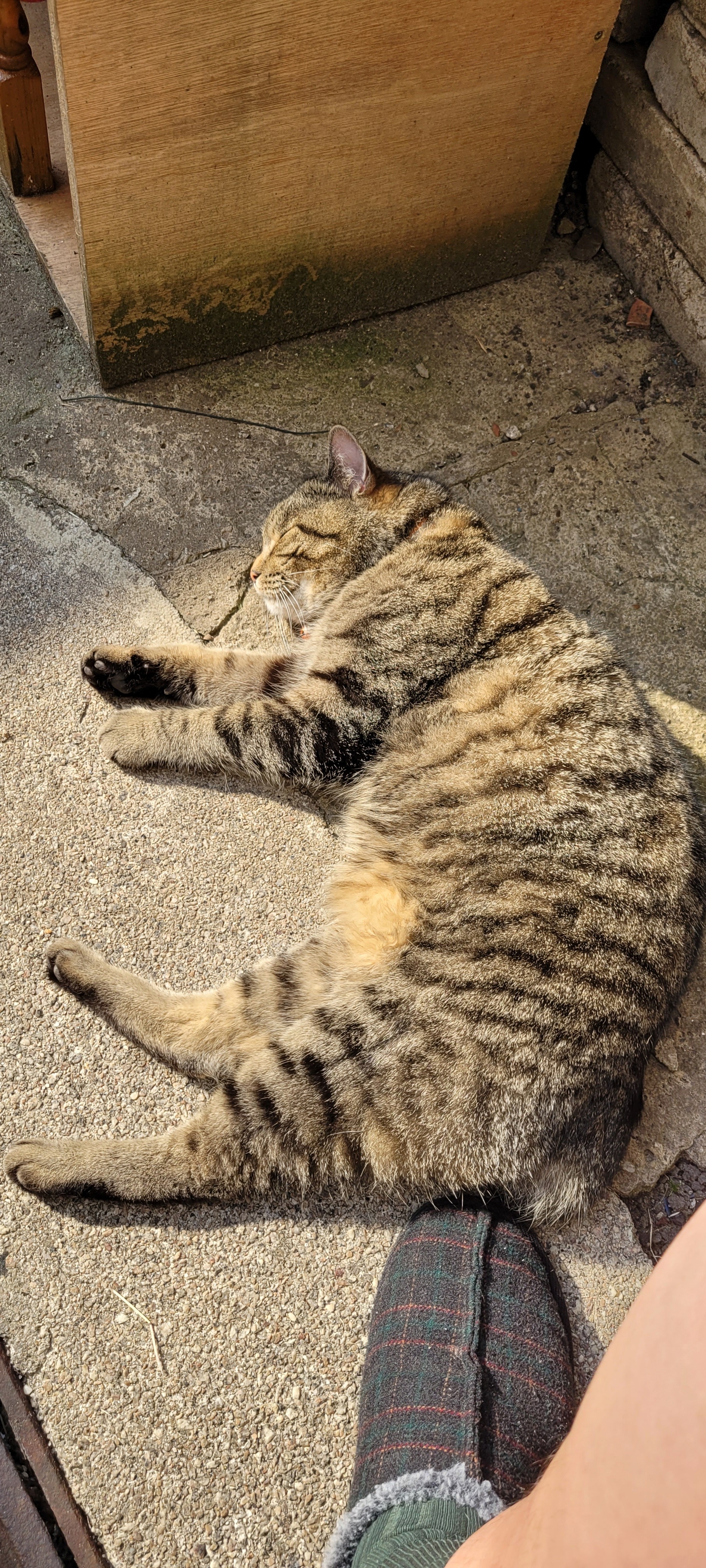That’s pretty much it, after several months, maybe even a year of wanting to take the leap, a couple days ago I finally did it. I just wanted to share this cuz I think it’s an absolute win, and I guess just see if anyone has any general advice to keep in mind during the process. I ended up choosing Fedora, right now I’m dual booting while I’m still in the process of finding software alternatives and getting everything set up, but trying to minimize my use of windows as much as possible, and so far I’ve been loving it. I love this community and I just wanted to thank everyone that has given any advice or suggestions in the past, i’m really excited about this and grateful that I could get to this point.
- Always keep a live USB of your distro handy
- Don’t ignore the terminal, you’re doing yourself a major disservice if you do. Terminal is life
- The ArchWiki isn’t just for Arch users
i always do have a distro live USB in my bag at all times. you never know who gets interested in the question “which distro do you use?”
I used to, but when someone finally got interested, the usb media was so outdated, that I had to download and write a new iso :D
Carry a dual USB A/USB C drive. You then flash distros from your phone. Distros on the fly!
Thanks for the tip, but my phone still uses micro usb lol
Bruh
Don’t be afraid to think for yourself.
You’re just using a computer. It’s not that complicated or religious.
I switched aid after windows 10 was launched. It was kind of tough in the beginning, but after a couple years any and all concerns about this or that not working or how to do something on Linux had disappeared.
Nowadays the os feels like a powerful tool that can do anything I need, and never gets in the way. It’s truly a pleasure to use.
So I guess id say that there is light at the end of the tunnel, even if the transition seems hard at times.
The best piece of advice I was given, that I seldom see repeated is this: learn how the filesystem is structured.
It makes everything else easier
I second this. Also, taking time to partition correctly for your purpose, can make disto hopping easier.
I think partitioning was one of the first skills I learned and the one I took most for granted. I had started on Arch cause I wanted to be cool and I liked arduous things, but I just ended up reading on LUKS, TPM, LVM, mdadm, etc. and different ways to set up your partitions. I never really took time to appreciate past me for learning it lol
This is very good advice
Originally read ‘from Linux to Windows’ and I was like, ‘What?’
Hey guys, my Dad was always a neck bearded Unix admin so I’ve grown up my whole life on FreeBSD, then moving over to Gentoo during my teen years.
I’m starting to have thoughts about switching to Windows given that’s what my new job uses, but I couldn’t find any instructions on compiling Windows outside of very outdated releases like 2000. Also, does anyone know if emacs and htop are compatible, as those are my most used applications?
… but I couldn’t find any instructions on compiling Windows outside of very outdated releases like 2000.
Damn! I was hoping to do it with Windows 7. Looks like that ship is doomed as well.
This can happen with people that refuse to learn!
I almost stopped reading at the first four words, tbh.
One of my friends did this. No clue how you can go from Arch back to windows… just wow. I found that insane.
That would be a wild experiment.
For some of the last really stubborn pieces of software that kept me locked it to at least dual booting windows, I’ve found running them in bottles is working really well. Bottles has a community preset for Fruity loops Studio, but it wasn’t really working. Oh it would run, but with massive input and audio lag, most VSTs just wouldn’t work with FL in that install. What does work, is creating a bottle for gaming, and then just installing everything through the “run exe” at the bottle prefix page. After 8 years of dual booting, I finally nuked my windows installs.
I made the switch in 2010.
I dual booted for a while, one day I realised that I hadn’t booted into windows for 3 months. At that point I reinstalled, no more dual booting. I haven’t looked back.
I keep a windows VM, currently has Win10 installed, I haven’t had to use it in about 3 years.
My advice is, keep dual booting. One day you’ll realise that booting into windows feels like a chore, you haven’t done it in months, so why keep it around…
Congrats! Just keep at it, Fedora is stable.
It gets easier with every solved problem!
If you play PC games (and already familiar with Fedora), check out Bazzite. The whole immutable thing is an adjustment, but I really like it.
Though not really an adjustment from Windows, more of an adjustment if you’re coming from another Linux distro.
Ban-test
You good.
I would warn against using an atomic distro for newbies that want a bit more than Internet surfing and gaming.
Handling such distros well requires specialized knowledge around them in particular, and not all common Linux solutions will fit.
All of Linux requires specialized knowledge. Immutable just takes different knowledge.
The real kicker with that is just that you can’t always just follow instructions you find online. Usually you can, as long as you’re doing them in a Distrobox, though.
I went with immutable as a newbie, and I think it’s great. It feels like getting in on the ground floor of the future.
Yeah, essentially that. But most advice on Linux is for non-immutable distros, so it’s better to start with the classic and then choose what you see fit.
definitely on board with bazzite for gaming computer. it seems to do well with everything else I throw at it also
I’ve been running it on my main PC (framework laptop) for I dunno 6 months now? And it’s been great.
Distrobox is dope, and “rpm-ostree” is super useful.
Aside from that, it’s incredibly stable. And games pretty much just work.
I’ve seen people say that “it’s not for tech people, but good for newbies,” and I have to disagree. Just because it works most of the time without having to tinker (but you can if you want) doesn’t mean it’s for noobs… That’s how your PC is supposed to function.
Lessons learned when switching:
Some things I didn’t expect just work differently on Linux and it took time to figure out those differences. For instance, a change to a network interface config on Windows usually takes effect when you hit the “OK” button. Linux requires toggling the interface for that change to take effect. That one took me a couple of frustrating hours to figure out. There are lots of other examples like this so keep it in mind if things aren’t working as you expect.
Trying to do absolutely everything on Linux right away was a mistake. I started switching back to Windows for quick tasks and then learning how to do those tasks on Linux when I could spend a few minutes figuring them out. Over time I spent more and more time running Linux and one day realized I hadn’t started Windows in months.
In addition to (or instead of) dual booting, create a virtual machine to allow you to use what you need in either OS without rebooting.
Lastly, if you find that you’re spending a lot of time fixing OS problems don’t be afraid to try something else. Haven’t spent much time with Fedora, but I use Mint daily because I don’t have to fuss with the OS much. Others in my household have more problems with Windows 11.
For instance, a change to a network interface config on Windows usually takes effect when you hit the “OK” button. Linux requires toggling the interface for that change to take effect.
That’s not a Linux thing so much as a your particular Linux distribution thing. Different Linuxes can have vastly different user interfaces for various things. Some distributions even go out of their way to be more similar to Windows.
Hmm, every distro I’ve tried (and I’ve tried a few) required a interface bounce. Maybe I just missed the ones that don’t.
Keep a cloud-synced notebook of bugs, ideas, and fixes. That way, you can help people in the future or know how to do things for yourself if you ever need to reinstall. I have notes for fixing things like my keyboard layout on GDM/SDDM or how to set up certain software in a privileged
podmancontainer.Yeah i keep a nextcloud synced Obsidian vault and I have a entry for fresh installing my popos system with a list of all the software I install and from where with an Obsidian link to a note of each individual software if it needs more info, like config settings of rapid photo Downloader so that my photos are always imported and named the same or how to add the repository for tabby so that it updates along with all the stuff when I do apt update
Post-Snowden and post-Windows, I also started with Fedora, and, well, it honestly didn’t go all that well (this of course was my experience! If you like Fedora and it works for you, then 👍! Not here to dis the distro!). Actually, I think it had more to do with GNOME than with Fedora, so it depends on which desktop environment you’re using; when I switched DE to Cinnamon all my problems seemed to vanish into thin air. And from there, I just went straight to Mint and have been happy as a clam ever since and never looked back.
In my experience, running Windows as a VM inside Mint was overall much better than dual booting, which can really get to be a pain after a while (and also I think that the Windows partition will sometimes overwrite the Linux part so be careful!); it sounds hard, but it isn’t—if old and senile Erinaceus can do it, you can too! Always happy to provide recommendations.
EDIT: Also (and again not to step on anyone’s toes), I never had good luck using Wine; this is perhaps because I was trying to run Photoshop and other heavy, Adobe-type things in it (this was before Creative Cloud). Other programs might work differently with it, but in every case for me, a VM has worked better. I don’t play games (I know, boring), but I sometimes wonder if it wasn’t for people’s dependence on Adobe products that Windows might finally start losing a lot of market share and eventually end up on the rubbish heap where it belongs.
Welcome to the world of Libre [as in free-software]
I’ve been wanting to take the leap, too. I’ve got Linux installed on my gaming laptop and I’ve been trying games one by one to see if they work. Next step is dual booting on my desktop and only switching to Windows when I absolutely can’t make something work. My biggest concern is that I have a bunch of games installed on various drives that are all Windows (NTFS?) formatted and I’m not sure if I’ll be able to run them on Linux. I really don’t want to have to reinstall all of them.
You will probably have to reinstall all of them under Wine or Proton or whatever. I don’t think it can import existing installations.
Linux can read and write to NTFS drives just fine. Just make sure you’re using the newer native (in-kernel) driver, ntfs3. The older user-mode driver, ntfs-3g, still works but has much worse performance, which I guess should be a concern if you’re going to run games off of it (ntfs-3g is fine for casual use)
Also, make sure you have backups. I don’t care how stable NTFS drivers are I don’t fucking trust them for daily use, especially writes.
I recommend copying files off of NTFS and onto ext4 if you’re able. If you can’t, try to keep operations to read only.
I’ve lost too many drives due to stupid issues (sometimes me making an error, sometimes the driver not working properly).
Backup:
- 3 different locations
- 2 different media formats
- 1 offsite
ntfs drives do work in linux, but there may be some issues sometimes. i switched alnost 2 years ago and i have distrohopped a bit. fedora and nobara had intermittent issues with the ntfs drive, it suddenly became unmountable and it takes some fighting to get it back. in mint, the drive constantly corrupts files and entire folders, and the only way to delete those is to boot into windows and delete them there.
There is a linux NTFS fix package, I forget the proper name, it tries to clean up the filesystem like windows would
My biggest concern is that I have a bunch of games installed on various drives that are all Windows (NTFS?) formatted and I’m not sure if I’ll be able to run them on Linux.
I’d check https://www.protondb.com/ and if they your favorite ones are native/gold/platinum then… move on. I’d initially NOT erase my drives and, assuming you have either patience and/or a fast connection, just let it re-download and install overnight, then enjoy. If need be bring the saves back (but again via Steam, should just work) and only once that’s done, erase the Windows partitions. This is a no risk process. Honestly some games will not work but IMHO this isn’t the question. The question rather is… will you have more playable games than time left, if so, then considering moving even without 100% coverage.
You can read NTFS drives; I still have shared drives from my Windows install despite barely using Windows at all.
You can generally import steam libraries, and then steam can do the proton work.
And you can sometimes run other programmes in Linux from the windows install - i.e. it can have it’s own Wine prefix in Linux and use the installed files on the NTFS. But this doesn’t always work - if the programme’s or game’s installer makes significant system changes or installs other software then they won’t exist in the Wine prefix and the game may not work. It’s better to install windows games fresh so everything is installed into the wine prefix.
And Lutris is well set up with scripts for installing a wide range of games from their installers; it will avoid problems reinstalling games fresh.
Advice is to build relationships with others who also use Linux. Find a chat room that you can stay in and stick with for a couple of years. It will be invaluable. Don’t try to do this purely from documentation, stack overflow, blog posts, and searching forums. Real live people is the way to go.
A lot of distros have their own Discord communities these days. It’s pretty easy to find people who can help in real time.
-
It’s not a race, take your time to read and understand what is what and how things are functioning together.
-
Enjoy your stay, it’s going to be your next home, take care of it; make it beautiful, make it efficient, make sure to get rid of all what is irritating you.
-
Start with the minimum and build from there.
-
And, FFS, make backups ;)
And, FFS, make backups ;)
Here’s a good tutorial for an easy to use backup solution: https://www.youtube.com/watch?v=W30wzKVwCHo
-


















